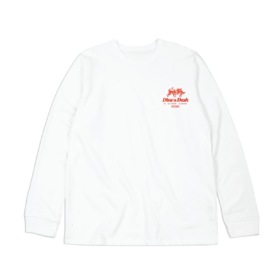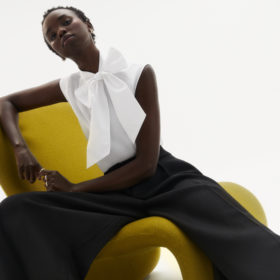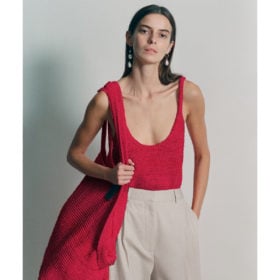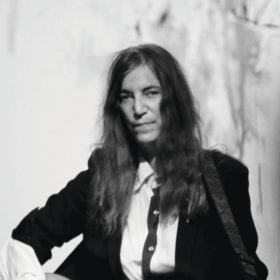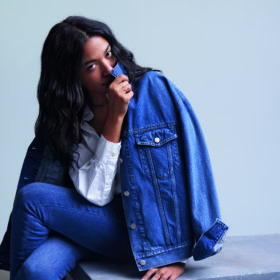With over ten years of experience creating bags for a variety of mass market brands, Montreal-based creative Linsey Myriam Bain decided to forge her own path forward with the launch of her eponymous label in 2019. She learned a lot during her tenure as an accessory expert, traveling to factories and gaining insight into consumer expectations; and she’s channeled this knowledge into the creation of unisex pieces that suit all needs and are made with intention.
“I’ve been in the industry for so long,” she says, noting that she started by working in various retail roles, which afforded her the ability to “understand how people relate to product.” While studying fashion design in post-secondary school (she studied art history before that), she also modelled briefly. But in addition to the historically problematic expectations within that aspect of the industry — “At one point, I didn’t know if I was skinny or not,” she recalls — she says the randomness of client meetings didn’t “align with my studies. [And] I saw a greater future for myself with design.”
This epiphany has been to our benefit. Bain’s bags are made in small quantities with fabrics sourced from Canadian suppliers, and feature organic and overstock materials. “I want to make sure that I keep a very small supply chain,” she notes, and says that moving forward she’d love to craft her pieces on-demand as her customer base expands. She’s also tapped into the exciting potential of new textiles, saying that she “would like to work with cactus leather [in the future]. It’s about growing and improving with every collection. I want to make good products that people like, and enjoy doing it.”

Given her expertise in the fashion industry, Bain identifies a core issue with sustainable design — it’s affordability — as a point that needs continual addressing and improvement by not only independent makers like herself, but the large-scale businesses that reach consumers at a mass level. “I’m thankful for Stella McCartney, but how many people can actually get clothing that’s made ethically, from the way people are treated to the waste at the factory and [creation of] excess product? How do we make sure that the big retailers — that we still need because there are people who need to shop for inexpensive products — are becoming sustainable?”
In addition to her thoughtful approach for making bags, Bain has committed to locally producing the non-medical face masks her brand began offering last Spring; a new mask drop will come later this week, boasting new colours like khaki and chocolate brown. “The masks were a natural addition,” she says, going on to reveal that making them also gave her the opportunity to be productive and proactive at a time when pushing product didn’t seem altogether important.

“It was a saving grace. Bags that last, like mine, will always be in a certain price range and I didn’t feel comfortable coming out with new products at the time. It didn’t feel right. At least by making masks, I was doing something useful for me, and for everybody. And it allowed me to be creative.” She shot the initial array of masks in her loft-style living space with local photographer Mallory Lowe, using non-agency models and playing with wigs to emphasize the collection’s range of eye-catching hues. “It’s allowed me to work with people in my community,” she says. Give-back is crucial to her business, and Bain has donated product to organization raffles like that of the Black Theatre Workshop and provided a portion of proceeds from the brand’s sales to initiatives like Hoodstock, an activism-centric group with a seven-point mandate that includes support of the arts and social justice actions.
“There’s so much talent in Montreal, it’s almost ridiculous,” Bain laughs. And the city’s notoriously creative denizens are counted in her circle, including DJ KidCrayola and textile designer Damien Ajavon, who recently appeared on the brand’s feed modelling its bright blue nylon Flat tote — one of the five core styles Bain currently offers.

The assortment also includes a petit crossbody and backpack, as well as a pouch designed with three options for wearing (waist, crossbody or with an evening-style chain). “I’m most proud of this piece,” she says, adding that new styles will appear once she knows if she’s received any award or grant money that she’s applied for this season. “New bags are designed, but I have to see if anything comes from that before moving forward,” she notes.
But Bain has attuned her fan base to the idea that good things come to those who wait, and she’s determined to only augment this sensibility as her label increases in presence — just don’t expect to see more product because there’s more demand. “I would never do four collections in a year,” she says. “That’s one thing I’ve learned about the industry — the pace is too much. I started this brand to have a legacy; to have something that represents my values and my views.” And we’ll be watching for what comes next.
The post Montreal Accessory Designer Linsey Myriam Bain on the Beauty of Going Slow appeared first on FASHION Magazine.
from FASHION Magazine https://ift.tt/3w9D3id
via babu31blog


